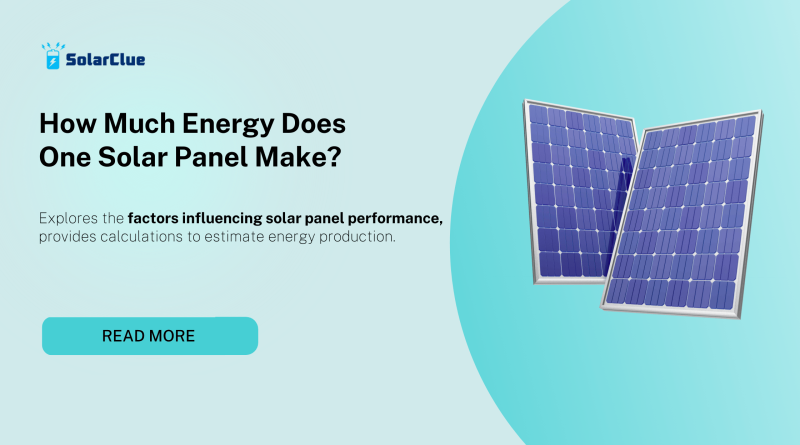How Much Energy Does One Solar Panel Make?
Solar panels are a cornerstone of renewable energy, converting sunlight into electricity. Understanding the power output of a single solar panel is crucial for designing an efficient solar energy system. This blog explores the factors influencing solar panel performance, provides calculations to estimate energy production, and explains how multiple panels can be combined to maximize overall power output.
Table of Contents
- 1 The Concept of Solar Panel Wattage and Its Significance
- 1.1 Factors Affecting Solar Panel Power Output
- 1.2 Calculating Energy Production Based on Panel Wattage and Peak Sun Hours
- 1.3 Comparing Different Solar Panel Types in Terms of Wattage
- 1.4 The Role of Location and Climate in Solar Panel Performance
- 1.5 Combining Multiple Panels for Higher Power Output
- 1.6 The Impact of Battery Storage on Energy Production
- 1.7 Tools and Software for Estimating Solar Panel Power Output
- 1.8 Real-World Case Studies of Single Solar Panel Performance
- 1.9 Energy Production of Different Solar Panel Types
- 1.10 FAQs
The Concept of Solar Panel Wattage and Its Significance
Solar Panel Wattage: The wattage rating of a solar panel indicates its maximum power output under standard test conditions (STC), which typically include a sunlight intensity of 1,000 watts per square meter and a temperature of 25°C. Common wattage ratings for residential solar panels range from 250W to 400W.
Significance: The wattage rating is directly related to the amount of electricity the panel can generate. Higher wattage panels produce more electricity, making them ideal for meeting larger energy demands.
Factors Affecting Solar Panel Power Output
Sunlight Intensity: The amount of sunlight a panel receives is the primary factor affecting its power output. More sunlight equals more electricity generation.
Temperature: Solar panels operate more efficiently at cooler temperatures. As temperature increases, panel efficiency decreases, leading to lower power output.
Shading: Even partial shading can significantly reduce a panel’s power output. Shading blocks sunlight from reaching the cells, disrupting electricity generation.
Panel Efficiency: The efficiency of a solar panel determines how well it converts sunlight into electricity. Higher efficiency panels produce more electricity from the same amount of sunlight compared to lower efficiency panels.
Calculating Energy Production Based on Panel Wattage and Peak Sun Hours
To estimate the energy production of a solar panel, you can use the following formula:
Energy Production (Wh)=Panel Wattage (W)×Peak Sun Hours (h)
Example Calculation:
- Panel Wattage: 300W
- Peak Sun Hours: 5 hours/day
Daily Energy Production=300W×5h=1,500Wh or 1.5kWh
Annual Energy Production=1.5kWh/day×365days=547.5kWh
The Impact of Panel Efficiency on Power Output
Panel Efficiency: Efficiency is the percentage of sunlight that a panel can convert into usable electricity. For example, a 20% efficient 300W panel will produce more electricity than an 18% efficient 300W panel because it converts sunlight more effectively.
Example Comparison:
- 18% Efficient 300W Panel: Converts 18% of sunlight into electricity.
- 20% Efficient 300W Panel: Converts 20% of sunlight into electricity, generating slightly more power under the same conditions.
Comparing Different Solar Panel Types in Terms of Wattage
Different types of solar panels have varying wattage ratings and efficiencies:
| Panel Type | Typical Wattage Range | Efficiency Range |
|---|---|---|
| Monocrystalline | 300W – 400W | 18% – 22% |
| Polycrystalline | 250W – 350W | 15% – 18% |
| Thin-Film | 150W – 250W | 10% – 12% |
The Role of Location and Climate in Solar Panel Performance
Location: The geographic location of your solar panel installation plays a crucial role in determining its performance. Areas closer to the equator receive more sunlight, resulting in higher power output.
Climate: Weather conditions, such as cloud cover and temperature, also impact solar panel performance. Panels in sunny, dry climates typically produce more energy than those in cloudy, wet climates.
Combining Multiple Panels for Higher Power Output
Series and Parallel Configurations: Multiple solar panels can be combined in series or parallel to increase overall system power output.
- Series Configuration: Increases the system voltage while keeping the current the same. This setup is beneficial for long-distance power transmission but requires more careful voltage management.
- Parallel Configuration: Increases the system current while keeping the voltage the same. This configuration is useful for systems requiring high current and helps reduce the impact of shading on individual panels.
Example:
- 4 x 300W Panels in Series: Total output = 1,200W (Higher voltage, same current).
- 4 x 300W Panels in Parallel: Total output = 1,200W (Higher current, same voltage).
The Impact of Battery Storage on Energy Production
Battery Storage: Adding battery storage to your solar panel system allows you to store excess energy generated during the day for use at night or during periods of low sunlight. This maximizes the utilization of solar energy and ensures a consistent power supply.
Tools and Software for Estimating Solar Panel Power Output
Several online tools and software are available to estimate the power output of solar panels. These tools take into account factors like location, panel type, system configuration, and energy usage patterns to provide accurate energy production estimates.
Real-World Case Studies of Single Solar Panel Performance
Case Study 1: 300W Monocrystalline Panel in Southern California
- Location: High sunlight availability (6 peak sun hours/day)
- Daily Output: 300W x 6h = 1.8kWh
- Annual Output: 1.8kWh/day x 365 days = 657kWh
Case Study 2: 250W Polycrystalline Panel in Northern Europe
- Location: Moderate sunlight availability (4 peak sun hours/day)
- Daily Output: 250W x 4h = 1kWh
- Annual Output: 1kWh/day x 365 days = 365kWh
Energy Production of Different Solar Panel Types
| Panel Type | Wattage | Peak Sun Hours | Daily Output (kWh) | Monthly Output (kWh) | Annual Output (kWh) |
|---|---|---|---|---|---|
| Monocrystalline | 300W | 5 hours | 1.5kWh | 45kWh | 547.5kWh |
| Polycrystalline | 250W | 4 hours | 1.0kWh | 30kWh | 365kWh |
| Thin-Film | 200W | 3 hours | 0.6kWh | 18kWh | 219kWh |
Conclusion
Understanding the power output of a solar panel is essential for optimizing your solar energy system. By considering factors like panel wattage, efficiency, sunlight intensity, and location, you can accurately estimate energy production and design a system that meets your energy needs. Whether you’re working with a single panel or combining multiple panels, this blog equips you with the knowledge to maximize your solar power output and ensure a reliable, sustainable energy source.
Here at SolarClue®, we offer a smart, practical, and “beautiful” solution. You will be answered for all the questions related to Solar.
We provide all kinds of brands that are the Best Solar panels in India.
If you are the one who is planning for the solar power system. Don’t hesitate to contact our team!
Looking forward to empowering you with solar energy, just like hundreds of our other clients!
FAQs
1. How do I calculate the power output of a single solar panel?
Multiply the panel’s wattage by the number of peak sun hours it receives. For example, a 300W panel with 5 peak sun hours produces 1,500Wh or 1.5kWh per day.
2. What factors affect the power output of a solar panel?
Sunlight intensity, temperature, shading, and panel efficiency are the primary factors influencing a solar panel’s power output.
3. How does panel efficiency impact energy production?
Higher efficiency panels convert more sunlight into electricity, leading to greater power output compared to lower efficiency panels of the same wattage.
4. Can I combine multiple panels to increase power output?
Yes, combining panels in series or parallel configurations can increase the overall power output of your solar system.
5. How does climate affect solar panel performance?
Climate plays a significant role in solar panel performance. Sunny, dry climates generally yield higher energy production than cloudy, wet climates.




